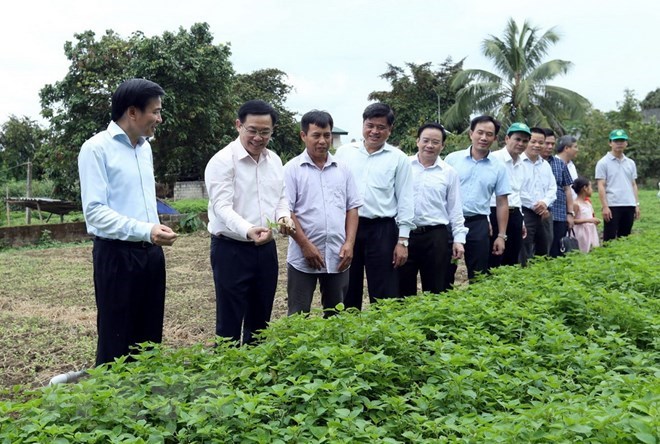Deputy PM urges creativity in building new rural areas
 |
|
Deputy Prime Minister Vuong Dinh Hue visits a model of growing clean vegetables of a local farmer in Dien Bien province (Photo: VNA) |
Speaking at a conference held in Dien Bien province on July 27 on building new rural areas in disadvantaged villages, the Deputy PM said while the Government cannot arrange sufficient resources for the work, many localities have found unique ways to achieve the target.
He cited as examples the combining of model new-style rural areas with tourism, or the One Commune One Product programme, which have been successfully carried out in Ha Tinh, Quang Ninh and Nam Dinh provinces.
Deputy PM Hue also asked local administrations to pay attention to the role of the local community, and engage the community in selecting suitable priorities in striving to meet categories for new style rural areas.
He required the Ministry of Agriculture and Rural Development to quickly complete the project on assisting disadvantaged villages and hamlets in poor communes in border, mountainous, coastal and island regions in building new style rural areas and reducing poverty sustainably in 2018-2020, in order to submit it to the Prime Minister for approval this year.
The project aims to reduce the household poverty rate by at least 3-4 percent a year and raise incomes of residents in target communes by at least 1.6-1.8 times compared to 2015.
The scheme will benefit some 3,513 villages and hamlets in 363 poor communes which have fulfilled under 10 categories of the new style rural areas in 35 provinces.
In order to earn the title of new style rural areas, a commune or district must meet 20 criteria covering a wide range of fields, from the development of infrastructure, the improvement of production capacity, environmental protection to the promotion of cultural values.
The national target programme on building new-styled rural areas was initiated by the Vietnamese Government in 2010 with the aim of developing rural regions. It initially had 19 criteria, and the set of criteria was increased to 20 in 2015.
Vietnam had 3,370 communes, or 37.76 percent of the total, recognised as new-style rural areas as of July this year, according to the Central Coordination Office for New Style Rural Area Development.
The ratio is expected to rise to at least 40 percent as of the end of this year, up 3.37 percent from 2017.

